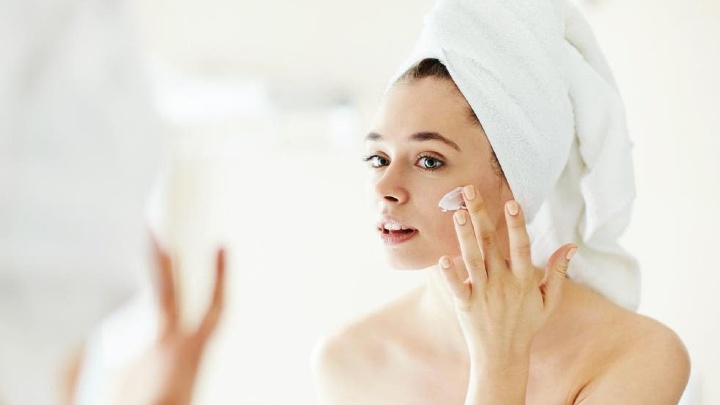If you are a fan of layering skincare products, then you will have questions about which active ingredient will complement which. For instance, niacinamide and retinol are excellent acne and anti-aging ingredients.
You can safely use a skincare product that contains niacinamide and follow up with a retinol-based product. Yes, you can do that and not worry about your skin flaring up.
This pair is one of the few that have received thumbs up from dermatologists. Although their mechanisms of action are quite different, yet, they complement each other and address your skin concerns.
Read on to see why and how you should use niacinamide with retinol to achieve flawless, glowing skin.
What does niacinamide do for your skin?
Niacinamide is the already converted form of vitamin B3, niacin. It is preferred because it is milder to use on the skin. Niacinamide has antibacterial and antioxidant properties that make it very suitable for treating acne, hyperpigmentation scars, facial wrinkles, and fine lines.
The topical application of niacinamide helps to reduce sebum production. And sebum, the skin’s natural oil, when in excess can lead to clogged pores and eventual acne breakouts.
Alongside its sebum reduction capacity, niacinamide gently exfoliates your skin. As a result, it prevents acne breakout and fades away existing acne and hyperpigmentation scars.
Furthermore, the antioxidant properties of niacinamide help to protect your skin from the formation of free radicals.
Niacinamide strengthens your natural barrier, which is your skin’s protector from harsh sun rays. Moreover, it acts as a humectant that helps your natural barrier to retain moisture and keep your skin hydrated.
This moisturizing property helps to soothe your skin and reduce redness.
This benefit slows down the aging process and smoothens fine lines and wrinkles. Overall, niacinamide improves the appearance of your skin by increasing cell turnover and promoting skin elasticity.
What does retinol do for your skin?
Retinol, the anti-aging specialist, is a vitamin A derivative. As a major anti-aging ingredient, it stimulates collagen production and increases cell turnover. This plumps your skin back to its youth and treats fine lines and wrinkles.
Applying retinol-based serums and creams strengthen your natural barrier and improve the texture of the outer layer of your skin. While stimulating collagen synthesis, retinol doubles to inhibit the action of enzymes that break down collagen.
Additionally, just like niacinamide, retinol is also an antioxidant. If used correctly, it forms a photo-protective layer over your skin that protects you from photoaging. Photoaging is premature aging resulting from prolonged exposure to UV rays.
Retinol is also touted as a very effective ingredient for acne treatment. This is because it penetrates deeper into your skin, unclogs your pores, and reduces acne formation. By increasing cell turnover, retinol fades acne and hyperpigmentation scars and brightens your skin.
Also, its anti-inflammatory properties calm your skin and prevent skin breakouts (this depends on how correctly you use this vitamin A derivative).
Can you use niacinamide with retinol?
Yes, you can.
Niacinamide is the ingredient that makes retinol tolerable. Pairing these two will calm your skin of the irritation retinol is likely to cause. Also, niacinamide hydrates your skin to prevent retinol from drying it out.
In certain skincare products, like serums and creams, you may find a combination of niacinamide and retinol. And this makes pairing even better. This way your skin can relish the mix and match.
Although retinol is sometimes hailed as a skin moisturizer, this is not without some downsides. It tends to dry out your skin and damage your natural barrier. Consequently, this increases the rate of transepidermal water loss.
Niacinamide becomes the savior of your skin. Layering it with retinol salvages this and protects your natural barrier from damage. As a result, there is no water loss, and it doubles to increase the hydration levels of your skin.
In addition, both vitamins are active within pH ranges that are beneficial to your skin (5.0-7.0 for niacinamide and 5.5-6.0 for retinol). They do not fall too far from each other. So, one enhances the effectiveness of the other.
Niacinamide and retinol are great anti-aging ingredients. They work in tandem to eliminate fine lines and wrinkles and plump your skin back to its youthful glow. Moreover, together, they slow down the aging process.
Can you use niacinamide with retinol for acne?
Yes, you can.
Niacinamide and retinol are good for treating existing acne and preventing more breakouts. These vitamins have good penetration power that helps them penetrate your skin and unclog your pores.
Their mild exfoliation properties help to loosen the bond between dead skin cells and sebum. They lift them off your skin and shrink the size of your pores.
Furthermore, niacinamide and retinol have great potential to reduce sebum production and make your skin less oily (which equals fewer breakouts).
In addition, they are anti-inflammatory ingredients that calm your skin from the redness caused by acne.
Frequent and prolonged exposure to sun rays worsen acne and cause hyperpigmentation. You can use this pair to reduce the appearance of acne scars and hyperpigmentation.
This makes them a great pair for oily and acne-prone skin. Also, sensitive skin types prone to acne breakouts due to any slight skin irritations can safely use niacinamide and retinol.
Why should you use niacinamide with retinol?
The major reason why you should use niacinamide with retinol is that they complement each other perfectly.
“Niacinamide has two helpful actions. It boosts ceramide production, an essential component of the epidermis’ bricks and mortar structure, which makes skin more robust and tolerant of irritants,” says Dr. Sam Bunting. One of such irritants is retinol.
Topical application of retinol alone can be quite irritating to your skin and cause it to dry out. Niacinamide protects your skin from this irritation and moisture loss.
Applying niacinamide before applying retinol to your skin increases your retinol tolerance, especially if you have sensitive skin. Also, retinol beginners can maximize this pairing while their skin acclimatizes to the vitamin A derivative.
Furthermore, the ceramide production boost that comes from niacinamide enhances retinol’s ability to improve the appearance of your skin. It doubles to enhance the anti-aging properties of retinol, treating fine lines and wrinkles without causing irritations.
Enlarged pores, which are characteristics of oily and combination skin, can be minimized when you pair niacinamide with retinol.
Both penetrate your skin and work on your pores; they reduce sebum production and shrink your pores. Niacinamide begins the increase in cell turnover by hydrating your skin. Therefore, it creates a good primer for retinol to do its work.
Overall, they complement each other and protect your skin barrier, treating and preventing acne breakouts. Moreover, they promote a firm and youthful complexion.
How to use niacinamide with retinol
1. Niacinamide and retinol combined in one product
Some products like serums and creams combine niacinamide and retinol in one formula. This makes the use easier and more convenient. Whether it’s a serum or cream, you should follow the rule of thumb of skincare.
Start with lightweight products and end with heavier products. If it’s a serum, make sure you layer an ideal moisturizer and eye cream. Most importantly, because of the photosensitivity of retinol, do not forget to apply a broad-spectrum sunscreen.
2. Niacinamide and retinol in two separate products
When you have niacinamide and retinol as two different products, you can either layer or use them at alternate times. Also, you can pre-treat your skin with niacinamide days or weeks before you introduce retinol.
If you want to layer products, use a niacinamide face wash or serum first. Then, you can apply retinol serum or moisturizer. However, because of the likely irritations, you should introduce retinol in smaller concentrations until your skin can tolerate it.
On the other hand, you may pre-treat your days with niacinamide products before using retinol. This will prep your skin to receive retinol. Also, it will immunize your natural barrier from the irritations that can cause transepidermal water loss.
Alternatively, you can use niacinamide during your AM routine and retinol for your PM routine. This way you’re protected from the photosensitivity caused by UV rays.
If you’d rather opt for daytime use (either layering or pre-treatment), you must layer a broad-spectrum sunscreen over your skin. Beyond niacinamide’s protection, SPF is necessary to shield your skin from sun damage.
Are there any potential side effects?
To begin with, niacinamide has been lauded to be very tolerable with every skin type. But generally, there will always be exceptions. So, if your skin does not tolerate niacinamide, it’ll certainly not tolerate pairing it with niacinamide.
Also, if you start with high concentrations of retinol, you’re bound to experience skin irritations. With such concentrations, you may experience skin redness, itching, and a stinging sensation.
In addition, during pregnancy or when receiving insulin and niacin therapy, pairing niacinamide with retinol is not a good idea.
FAQs

Should you use niacinamide before or after retinol?
Apply niacinamide before retinol.
Using niacinamide before layering retinol will protect your skin from drying out, a common effect of using retinol. Also, it prepares your skin to receive and enhance the action of retinol.
Niacinamide strengthens your natural barrier and hydrates it. And when your skin is hydrated, retinol absorbs quickly and penetrates better. Moreover, niacinamide softens your skin in preparation for the smoothening of fine lines and wrinkles.
Is niacinamide or retinol better for acne?
Retinol is a more effective ingredient than niacinamide for acne treatment.
However, the drying effect it has on the skin is a major downside of retinol. Therefore, you cannot use retinol without pairing it with another ingredient like niacinamide.
In essence, neither is effective or better on its own. To treat acne and its scars, you need both to complement each other.
When should you use niacinamide with retinol?
The best time to pair niacinamide and retinol is during your night routine.
At this time, your skin is not exposed to the sun’s rays. Moreover, during the night, your skin goes into self-repair. So, it makes a good time for retinol to smoothen the fine lines and facial wrinkles.
However, you can use it during the day. Most importantly, always use broad-spectrum sunscreen during the day if you’re using retinol in your routine.
Can you use niacinamide with retinol and hyaluronic acid?
Yes, you can.
Hyaluronic acid is safe to use. It pairs with almost every other skincare ingredient. It is one ingredient that soothes your skin with a moisture boost. Pairing it with niacinamide and retinol is certainly not a bad idea.
With niacinamide, it will soothe and protect your skin from being irritated with retinol. Additionally, they both work together to regulate sebum production. Begin with hyaluronic acid and then, apply niacinamide before retinol.
Conclusion
Skincare does not have to be a daunting task if you have answers to your questions. If you are a fan of layering skincare ingredients, you should be conversant with mixing and matching. Beyond what these ingredients are touted to do, you should know whether your skin will appreciate them.
Niacinamide and retinol are essential vitamins your skin needs to look its best. However, how much you get from them depends on the correct application. Individually or together, they improve the appearance of your skin and reduce sebum production, which is important for acne treatment.
Niacinamide and retinol are the pair you need if you’re looking to treat skin conditions like fine lines, wrinkles, hyperpigmentation, and altered skin texture.
Thanks for reading.
You can get more helpful beauty tips here on MBGON.
